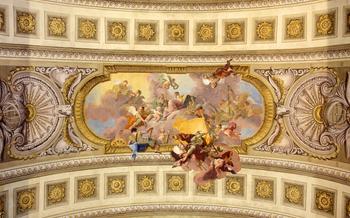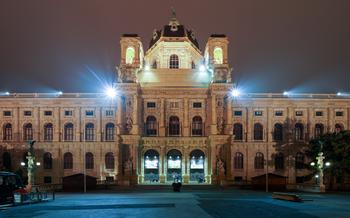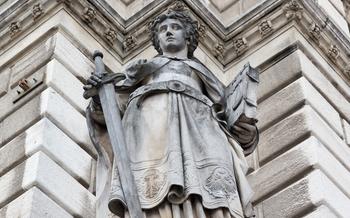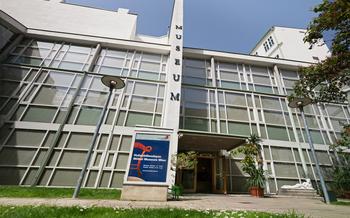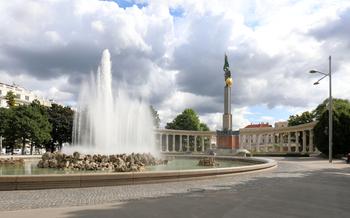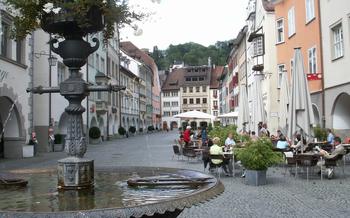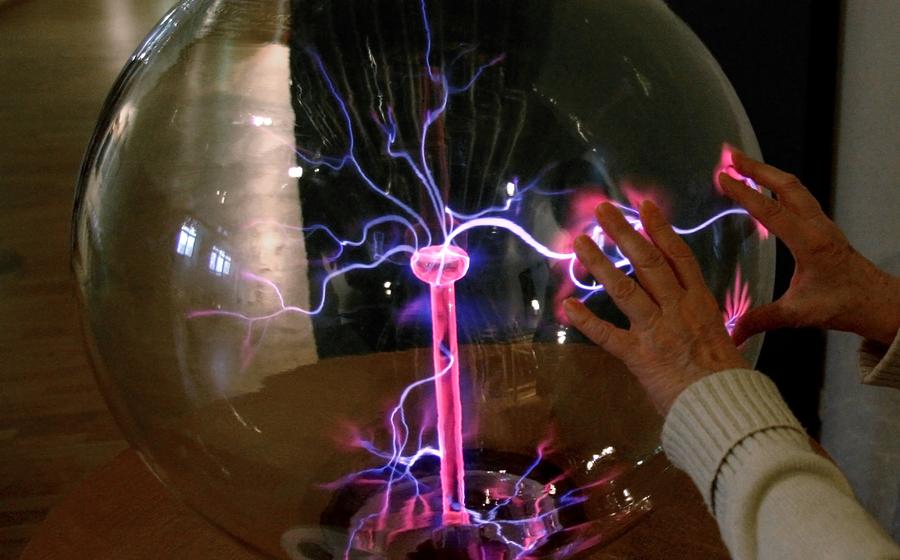
Globe Museum
- Exploring the Globe Collection: A World in Miniature
- The History of Globe Making: A Craft Through the Ages
- The Globe as a Symbol of Exploration and Discovery
- The Globe and the Cosmos: A Celestial Perspective
- The Globe in Art, Literature, and Film: A Cultural Icon
- The Globe and Education: A World of Learning
- Interactive Learning with Globes
- The Globe in the Digital Age: A Virtual Journey
- Globes and Sustainability: A Global Perspective
- The Globe and the Future: A Changing World
- The Globe Museum Shop: Souvenirs and Treasures
- The Globe Museum for Children: A World of Wonder
- The Globe Museum and Accessibility: A Welcoming Space for All
- Insider Tip: The Globe Museum After Hours
Exploring the Globe Collection: A World in Miniature
The Globe Museum in Vienna boasts a remarkable collection of globes that offers a fascinating journey through the history of cartography and the evolution of our understanding of the world. The museum's collection includes over 200 globes, ranging from small handheld models to large floor-standing terrestrial and celestial globes.
One of the highlights of the collection is the "Erdapfel," or "Earth Apple," created by Martin Behaim in 149This globe is the oldest surviving globe and is considered a masterpiece of Renaissance cartography. It depicts the world as it was known at the time, including the discoveries of Christopher Columbus's first voyage to the Americas.
Another noteworthy globe is the "Globus Blaeu," created by the Dutch cartographer Joan Blaeu in 166This globe is known for its intricate detail and accuracy, and it was used by seafarers and explorers for centuries. It features detailed depictions of coastlines, mountains, and rivers, as well as illustrations of ships and sea monsters.
The Globe Museum also houses a collection of celestial globes, which offer a glimpse into the history of astronomy and the human fascination with the night sky. These globes depict the constellations, planets, and stars as they were known at the time they were created. One of the most impressive celestial globes in the collection is the "Globe Celeste," created by Vincenzo Coronelli in 168This globe features detailed illustrations of the constellations, as well as depictions of the planets and their moons.
In addition to its permanent collection, the Globe Museum also hosts temporary exhibitions and displays that focus on specific aspects of cartography and globe making. These exhibitions often feature rare and unique globes from around the world, as well as interactive exhibits and educational programs for visitors of all ages.
The History of Globe Making: A Craft Through the Ages
The history of globe making is a fascinating journey that spans centuries and cultures. The earliest known globes date back to ancient Greece, where philosophers and astronomers such as Anaximander and Pythagoras used them to illustrate their theories about the Earth's shape and the cosmos. These early globes were often made of wood, metal, or clay and were decorated with hand-painted maps and celestial charts.
Over time, globe making evolved into a specialized craft, with skilled artisans and cartographers dedicating their lives to creating these intricate spheres. In the Middle Ages, globes were used primarily for educational and religious purposes, often displayed in monasteries and universities. The invention of the printing press in the 15th century revolutionized globe making, as it allowed for the mass production of printed maps and gores, which could be assembled into globes with greater accuracy and detail.
The Age of Exploration in the 16th and 17th centuries saw a surge in demand for globes, as explorers and navigators used them to chart their journeys and discover new lands. Famous globe makers of this era include Martin Behaim, who created the first known terrestrial globe in 1492, and Gerardus Mercator, who introduced the Mercator projection, which is still widely used in modern maps and globes.
In the 18th and 19th centuries, globe making continued to flourish, with the development of new techniques and materials. Globes were made from papier-mâché, plaster, and even glass, and were often adorned with elaborate engravings and artwork. The rise of scientific exploration and the mapping of the polar regions led to the creation of more accurate and detailed globes, which were used by scientists and geographers to study the Earth's surface and its features.
Throughout history, globes have played a crucial role in advancing our understanding of the world and the universe. They have been used by scholars, explorers, navigators, and educators to teach, learn, and explore the wonders of our planet and beyond.
The Globe as a Symbol of Exploration and Discovery
From the days of intrepid sailors charting unknown waters to modern-day adventurers pushing the boundaries of human knowledge, globes have played a pivotal role in the history of exploration and discovery. These spherical wonders were not just decorative objects but essential tools that guided navigators across treacherous seas and helped explorers envision the vastness of the world they sought to conquer.
Famous explorers like Christopher Columbus, Vasco da Gama, and Ferdinand Magellan relied on globes to plan their epic voyages. These globes, often meticulously crafted by hand, provided a visual representation of the Earth's surface, enabling explorers to determine their position, chart their course, and anticipate the challenges that lay ahead.
During the Age of Exploration, globes were not just navigational aids but also symbols of scientific curiosity and the thirst for knowledge. They fueled the imaginations of explorers and inspired them to venture into uncharted territories, driven by the desire to unravel the mysteries of the world. The globes they carried with them became tangible representations of their dreams and aspirations, embodying the spirit of adventure that defined that era.
The impact of globes on exploration and discovery cannot be overstated. They were the precursors to modern maps and GPS systems, providing a crucial framework for understanding the world's geography and facilitating the exchange of knowledge between different cultures. Globes played a vital role in shaping the course of history, as they guided explorers towards new lands, new discoveries, and a deeper understanding of our planet.
The Globe and the Cosmos: A Celestial Perspective
Globes have played a significant role in the study of the cosmos and astronomy throughout history. Some globes in the museum's collection depict not only the Earth but also the night sky and constellations, providing an accurate representation of the celestial sphere. These celestial globes are a testament to the skill and knowledge of globe makers who sought to capture the beauty and mystery of the universe.
Historically, celestial globes were used by astronomers and navigators to chart the positions of stars, planets, and other heavenly bodies. By aligning the globe with the night sky, they could determine the time, identify constellations, and predict the movements of celestial objects. The Globe Museum's collection includes several celestial globes from different periods, showcasing the evolution of astronomical knowledge and the changing understanding of the universe.
In addition to their practical use, celestial globes also held symbolic and cultural significance. They represented the connection between the Earth and the heavens, and were often used to illustrate cosmological theories and religious beliefs. The intricate and detailed craftsmanship of these globes reflects the fascination and awe that humans have felt towards the cosmos throughout history.
Today, globes continue to be used in astronomy and space exploration. Digital globes allow astronomers to visualize and analyze vast amounts of data about the universe, including the positions of stars, galaxies, and other celestial objects. Globes are also used to plan and guide space missions, helping scientists and engineers to understand the distances, trajectories, and relationships between different planets and stars.
The Globe in Art, Literature, and Film: A Cultural Icon
Globes have transcended their practical function as navigational and educational tools to become cultural icons embraced by art, literature, and film. In art, globes have been depicted as decorative elements, symbolizing knowledge, exploration, and adventure. In the painting "The Ambassadors" by Hans Holbein the Younger, a celestial globe sits prominently in the foreground, representing the sophisticated scientific interests of the depicted individuals.
In literature, globes have been used as symbols of knowledge and curiosity, as seen in Jules Verne's classic novel "Around the World in 80 Days," where a globe serves as a visual representation of the protagonist's ambitious journey.
In film, globes have played various roles, often symbolizing exploration and discovery. In the movie "Indiana Jones and the Last Crusade," a globe is used as a key to unlock a secret chamber, highlighting its role as a gateway to hidden knowledge and adventure.
In popular culture and media, globes have become ubiquitous symbols of knowledge, exploration, and the interconnectedness of the world. From their appearance on TV shows like "The Simpsons" to their use in logos and branding, globes have become instantly recognizable icons.
The Globe and Education: A World of Learning
Globes have long been recognized as invaluable educational tools, particularly in the fields of geography and history. In classrooms around the world, globes are used to teach students about the different countries, cultures, and continents that make up our planet. By spinning the globe, students can gain a sense of the relative positions of different places and understand how they are connected.
Globes are also used to teach students about the physical features of the Earth, such as mountains, rivers, and oceans. By studying a globe, students can learn about the distribution of land and water on the planet and how it affects climate and weather patterns. Globes can also be used to teach students about the different time zones around the world and how they are related to the rotation of the Earth.
In addition to their use in geography and history classes, globes are also used in other subjects, such as social studies, environmental science, and global studies. By using globes, students can learn about the interdependence of different countries and cultures and the challenges facing our planet in the 21st century.
Globes are not just for students; they can also be used by people of all ages to learn about the world around them. Whether you are a child exploring the globe for the first time or an adult looking to expand your knowledge of the planet, a globe can be a valuable resource.
Interactive Learning with Globes
In recent years, globes have become increasingly interactive, making them even more engaging and educational for learners of all ages. Interactive globes often feature touchscreens or augmented reality technology that allows users to explore the globe in new and exciting ways.
For example, some interactive globes allow users to zoom in on specific locations to see detailed maps and information. Others allow users to track the movement of the sun and stars across the sky or to simulate the rotation of the Earth. Interactive globes can also be used to play games and quizzes that help students learn about geography and other subjects.
The use of interactive globes in education is on the rise, as they offer a number of advantages over traditional globes. Interactive globes are more engaging and motivating for students, and they can help students to learn more effectively. Interactive globes can also be used to differentiate instruction, as they can be adapted to meet the needs of different learners.
The Globe in the Digital Age: A Virtual Journey
The advent of the digital age has brought about a new dimension to globe making and exploration. In the 21st century, interactive online globes and virtual reality have revolutionized the way we interact with and learn about our planet.
Online globes offer a wealth of features and functionalities that were previously impossible with traditional globes. They can be zoomed in and out to reveal intricate details, rotated to provide different perspectives, and layered with various data sets, such as population density, climate patterns, and historical events.
Virtual reality (VR) takes the globe experience to the next level by immersing users in a fully interactive 3D environment. With VR globes, users can "fly" around the world, explore different landscapes, and even step back in time to see how the Earth has changed over the centuries.
The rise of digital globes has also led to the development of geospatial technologies and mapping applications. These tools allow users to create their own maps, overlay data, and analyze spatial relationships. Globes have become essential tools for urban planning, environmental modeling, and a wide range of other fields.
Whether you're a student, a researcher, or simply someone who is curious about the world, digital globes offer an immersive and interactive way to explore our planet. From the comfort of your own home, you can journey to far-off lands, learn about different cultures, and gain a deeper understanding of our interconnected world.
Globes and Sustainability: A Global Perspective
In the era of climate change and environmental challenges, globes play a crucial role in raising awareness and promoting sustainability. They offer a comprehensive view of the Earth, enabling us to visualize the interconnectedness of ecosystems and the impact of human activities on our planet. By showcasing the distribution of resources, climate patterns, and environmental issues, globes serve as powerful tools for understanding the urgency of sustainable development and conservation efforts.
Environmental organizations and sustainability advocates use globes to illustrate the consequences of deforestation, pollution, and climate change. They highlight the importance of preserving biodiversity, promoting renewable energy sources, and adopting sustainable practices. Globes help us grasp the global scale of environmental challenges and inspire us to take collective action towards a greener and more sustainable future.
In addition, globes are valuable tools for urban planning and sustainable development. They provide a spatial context for decision-makers to visualize the impact of infrastructure projects, land use changes, and conservation initiatives. By understanding the interrelationships between different regions and ecosystems, planners can make informed choices that minimize environmental impact and promote sustainable growth.
Overall, globes serve as symbols of the interconnectedness of the world's ecosystems and the importance of global cooperation in addressing environmental challenges. They empower us to think globally and act locally, fostering a sense of responsibility for the well-being of our planet and future generations.
The Globe and the Future: A Changing World
In an era marked by global challenges and opportunities, the Globe Museum stands as a powerful reminder of our interconnectedness and the importance of understanding the world we inhabit. Globes serve as invaluable tools for comprehending complex global issues, such as climate change, environmental degradation, and sustainable development. They offer a visual representation of the Earth's ecosystems, allowing us to grasp the scale and urgency of these challenges.
Moreover, globes play a crucial role in planning and decision-making processes aimed at addressing global issues. By providing a comprehensive view of the Earth's geography, globes enable policymakers, scientists, and educators to identify patterns, trends, and potential solutions. They help us visualize the impact of human activities on the environment and facilitate discussions around sustainable development strategies.
In a world grappling with uncertainty and change, globes serve as beacons of hope and progress. They remind us of the beauty and diversity of our planet and inspire us to work together towards a more sustainable and equitable future. As we navigate the complexities of the 21st century, globes continue to be essential tools for understanding, planning, and fostering global cooperation.
The Globe Museum Shop: Souvenirs and Treasures
The Globe Museum's gift shop is a treasure trove of unique souvenirs and gifts inspired by the museum's collection. Visitors can find a wide range of items, including replicas of globes from different eras, books about the history of globes and cartography, maps of the world and individual countries, and educational materials for children. The shop also offers a variety of souvenirs, such as postcards, magnets, and keychains, featuring images of globes and world maps.
For those looking for something truly special, the museum shop offers a selection of limited-edition and one-of-a-kind items, such as handmade globes crafted by local artisans. These unique pieces make excellent gifts for globe enthusiasts and collectors.
Practical Information:
- Location: The Globe Museum shop is located on the ground floor of the museum building.
- Hours of Operation: The shop is open during the same hours as the museum, typically from 10 am to 5 pm daily.
- Prices: Prices for souvenirs and gifts range from a few euros for postcards and magnets to several hundred euros for handmade globes.
- Payment Methods: The shop accepts cash, credit cards, and debit cards.
The Globe Museum for Children: A World of Wonder
The Globe Museum is not just a destination for adults; it also offers an exciting and educational experience for young minds. The museum's dedicated children's section, known as the Globe Museum for Children, is a wonderland of interactive exhibits, hands-on activities, and engaging programs designed to spark curiosity and ignite a passion for exploration in young visitors.
At the Globe Museum for Children, kids can embark on a journey of discovery as they interact with colorful and interactive globes of all shapes and sizes. They can learn about different countries and cultures, explore the wonders of the night sky, and even create their own miniature globes using a variety of materials.
The museum's dedicated staff of educators and facilitators are on hand to guide children through the exhibits, answer their questions, and encourage them to explore the world from different perspectives. Regular workshops and events are organized throughout the year, providing children with opportunities to engage in hands-on activities, create their own globes, and learn about the history and significance of these fascinating objects.
The Globe Museum for Children is a place where learning and fun go hand in hand. It's a space designed to inspire young minds, foster a love of geography and exploration, and help them develop a global perspective from a young age.
Practical Information:
- The Globe Museum for Children is located within the main Globe Museum building and is accessible during regular museum hours.
- Admission to the children's section is included in the general museum ticket.
- Children's workshops and events require advance booking and may have additional fees.
- The museum provides a range of educational resources and materials for children, including activity sheets, quizzes, and interactive games.
- Parents and guardians are encouraged to accompany young children and participate in the activities together.
The Globe Museum and Accessibility: A Welcoming Space for All
The Globe Museum is committed to creating an inclusive and welcoming environment for all visitors, regardless of their abilities or disabilities. To this end, the museum has implemented various accessibility features and accommodations to ensure that everyone can have a fulfilling and enjoyable experience.
Wheelchair users and visitors with limited mobility will find ramps and elevators conveniently placed throughout the museum, allowing them to navigate all levels of the building without difficulty. Additionally, the museum provides wheelchairs for visitors who may need them, subject to availability.
For visitors who are deaf or hard of hearing, the museum offers audio guides with clear and concise descriptions of the exhibits. These audio guides are available in multiple languages, ensuring that visitors from different linguistic backgrounds can access the information provided.
The museum staff is trained to be attentive and supportive of visitors with disabilities. They are equipped with the knowledge and skills to assist visitors with any special needs or requests, ensuring that everyone feels comfortable and included during their visit.
Accessible parking spaces are available near the museum entrance for visitors with disabilities. These spaces are clearly marked and conveniently located to provide easy access to the museum.
By prioritizing accessibility, the Globe Museum aims to create a welcoming and inclusive environment where all visitors can explore the world of globes and gain valuable insights into the history, science, and art of cartography.
Insider Tip: The Globe Museum After Hours
For an exclusive and unforgettable experience, consider visiting the Globe Museum after hours. During these special events, the museum transforms into a unique venue for private tours and group bookings. Imagine wandering through the dimly lit galleries, encountering the fascinating globes under a different light, and delving deeper into their stories with the guidance of a knowledgeable guide.
After-hours visits to the Globe Museum offer a rare opportunity to explore the collection in a more intimate setting. Whether you're a globe enthusiast, a history buff, or simply seeking a unique cultural experience, this is your chance to immerse yourself in the world of globes without the crowds.
To arrange an after-hours visit, contact the museum in advance to inquire about availability and pricing. Whether you're a group of friends, colleagues, or family members, a private tour of the Globe Museum after hours is sure to create lasting memories and provide a deeper appreciation for the wonders of our world.
